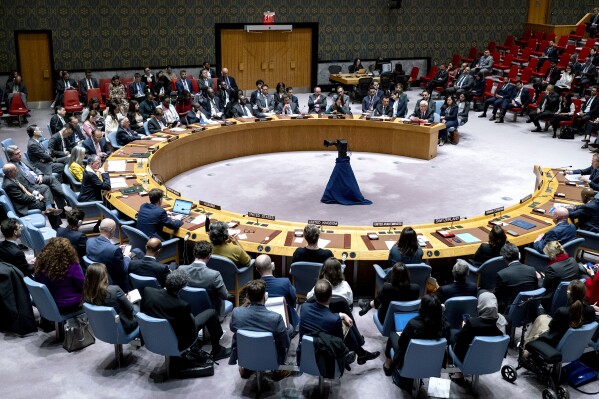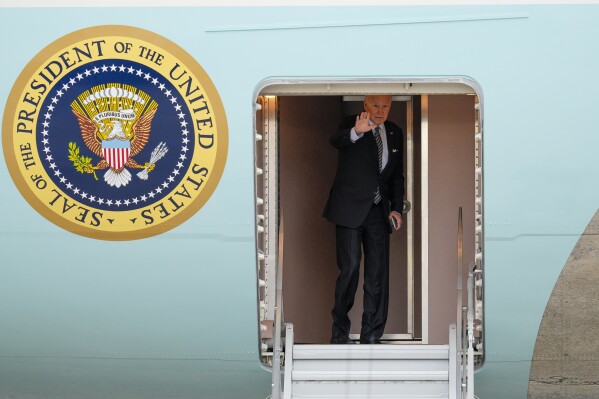Gaza’s doctors struggle to save hospital blast survivors as Middle East rage grows
KHAN YOUNIS, Gaza Strip (AP) — Doctors in Gaza City faced with dwindling medical supplies performed surgery on hospital floors, often without anesthesia, in a desperate bid to save badly wounded victims of a massive blast that killed hundreds of Palestinians sheltering in a nearby hospital amid Israeli bombings and a blockade of the territory.
The Hamas militant group blamed the blast on an Israeli airstrike, while the Israeli military blamed a rocket misfired by other Palestinian militants. At least 500 people were killed, the Hamas-run Health Ministry said.
Rage at the hospital carnage spread through the Middle East as U.S. President Joe Biden headed to the region in hopes of stopping a spread of the war, which started after Hamas militants attacked towns and cities across southern Israel last week.
Jordan’s foreign minister said his country canceled a meeting there between Biden, Jordan’s King Abdullah II, Palestinian President Mahmoud Abbas and Egyptian President Abdel Fattah el-Sissi. Biden will now visit only Israel, a White House official said.
 UN to vote on Gaza resolution that would condemn attack by Hamas and all violence against civilians
UN to vote on Gaza resolution that would condemn attack by Hamas and all violence against civilians
 Former Treasury Secretary Lew, Biden’s pick for ambassador to Israel, to face senators at hearing
Former Treasury Secretary Lew, Biden’s pick for ambassador to Israel, to face senators at hearing
 Biden will be plunging into Middle East turmoil on his visit to Israel
Biden will be plunging into Middle East turmoil on his visit to Israel
The war between Israel and Hamas was “pushing the region to the brink,” Jordanian Foreign Minister Ayman Safadi told state-run television.
Israel continued its airstrikes on Gaza on Wednesday, according to Gaza’s interior ministry.
The explosion at the al-Ahli Hospital on Tuesday night left gruesome scenes. Hundreds of Palestinians had taken refuge in al-Ahli and other hospitals in Gaza City, hoping they would be spared bombardment after Israel ordered all residents of the city and surrounding areas to evacuate to the southern Gaza Strip.
Video that The Associated Press confirmed was from the hospital showed the hospital grounds strewn with torn bodies, many of them young children, as fire engulfed the building. The grass was strewn with blankets, school backpacks and other belongings. On Wednesday morning the blast scene was littered with charred cars and the ground was blackened by debris.
Ambulances and private cars rushed some 350 casualties to Gaza City’s main hospital, al-Shifa, which was already overwhelmed with wounded from other strikes, said its director, Mohammed Abu Selmia.
Victims arrived with gruesome injuries, Gaza Health Ministry spokesperson Ashraf al-Qidra said. Some were decapitated, disemboweled, or missing limbs.
Doctors in the overwhelmed hospital resorted to performing surgery on floor and in the halls, mostly without anesthesia.
“We need equipment, we need medicine, we need beds, we need anesthesia, we need everything,” Abu Selmia said. He warned that fuel for the hospital’s generators would run out within hours, forcing a complete shutdown, unless supplies enter the Gaza Strip.
The bloodshed unfolded as the U.S. tried to convince Israel to allow the delivery of supplies to desperate civilians, aid groups and hospitals in the tiny Gaza Strip, which has been under a complete siege since Hamas’ deadly rampage last week. Hundreds of thousands of increasingly desperate people were searching for bread and water.
Hamas called Tuesday’s hospital blast “a horrific massacre,” saying it was caused by an Israeli strike.
The Israeli military blamed the blast on Islamic Jihad, a smaller, more radical Palestinian militant group that often works with Hamas. The military said Islamic Jihad militants had fired a barrage of rockets near the hospital and that “intelligence from multiple sources” indicated the group was responsible.
In a briefing with reporters, the chief army spokesman, Rear Adm. Daniel Hagari, said the army determined there were no air force, ground or naval attacks in the area at the time of the blast. He said radar detected outgoing rocket fire at the same moment, and intercepted communications between militant groups indicated that Islamic Jihad fired the rockets.
Hagari also shared aerial footage collected by a military drone that showed a blast that he said was inconsistent with Israeli weaponry. He said the explosion occurred in the building’s parking lot, and he noted that the death toll could not be confirmed.
Since the war began, the military said in a statement that roughly 450 rockets fired at Israel by militant groups had landed in Gaza, “endangering and harming the lives of Gazan residents.”
Islamic Jihad dismissed those claims, accusing Israel of “trying hard to evade responsibility for the brutal massacre it committed.”
The group pointed to Israel’s order that Al-Ahli be evacuated and reports of a previous blast at the hospital as proof that the hospital was an Israeli target. It also said the scale of the explosion, the angle of the bomb’s fall and the extent of the destruction all pointed to Israel.
Before the al-Alhi Hospital deaths, Israeli strikes on Gaza killed at least 2,778 people and wounded 9,700, according to the Gaza Health Ministry, and nearly two-thirds of those killed were children. Another 1,200 people across Gaza are believed to be buried under the rubble, alive or dead, health authorities said.
More than 1,400 people in Israel have been killed, mostly civilians who were slain in Hamas’ Oct. 7 attack. The assault also resulted in some 200 being taken captive into Gaza. Militants in Gaza have launched rockets every day since, aiming at cities across Israel.
Protests erupted across the Middle East. In Amman, a palace statement said Jordan’s king condemned “the ugly massacre perpetrated by Israel against innocent civilians.”
The king “warned that this war, which has entered a dangerous phase, will plunge the region into an unspeakable disaster,” the statement said.
With troops massed along the border, Israel has been expected to launch a ground invasion into Gaza.
Throughout the day Tuesday, airstrikes killed dozens of civilians and at least one senior Hamas figure in the southern half of the Gaza Strip, where the Israeli military told fleeing Palestinians to go. An Associated Press reporter saw around 50 bodies brought to Nasser Hospital after strikes in the southern city of Khan Younis.
The Israeli military said it was targeting Hamas hideouts, infrastructure and command centers.
Israeli Prime Minister Benjamin Netanyahu sought to put the blame on Hamas for Israel’s retaliatory attacks and the rising civilian casualties in Gaza. “Not only is it targeting and murdering civilians with unprecedented savagery, it’s hiding behind civilians,” he said.
With Israel barring entry of most water, fuel and food into Gaza since Hamas’ brutal attack, U.S. Secretary of State Antony Blinken secured an agreement with Netanyahu to discuss creation of a mechanism for delivering aid to the territory’s 2.3 million people. But aid was not getting in as of Wednesday morning.
More than 1 million Palestinians have fled their homes — roughly half of Gaza’s population — and 60% are now in the approximately 14-kilometer (8-mile) long area south of the evacuation zone, the U.N. said.
The Israeli military again called on Palestinians to move out of Gaza City and head south, saying that if aid were to be delivered it would be near the city of Khan Younis in south Gaza.
At the Rafah crossing, Gaza’s only connection to Egypt, truckloads of aid have been waiting to enter for more than a day.
___
Kullab reported from Baghdad. Nessman reported from Jerusalem. Lee reported from Amman. Associated Press journalists Amy Teibel in Jerusalem; Abby Sewell in Beirut; Samy Magdy and Jack Jeffrey in Cairo; and Ashraf Sweilam in el-Arish, Egypt contributed to this report.
Disclaimer: The copyright of this article belongs to the original author. Reposting this article is solely for the purpose of information dissemination and does not constitute any investment advice. If there is any infringement, please contact us immediately. We will make corrections or deletions as necessary. Thank you.


